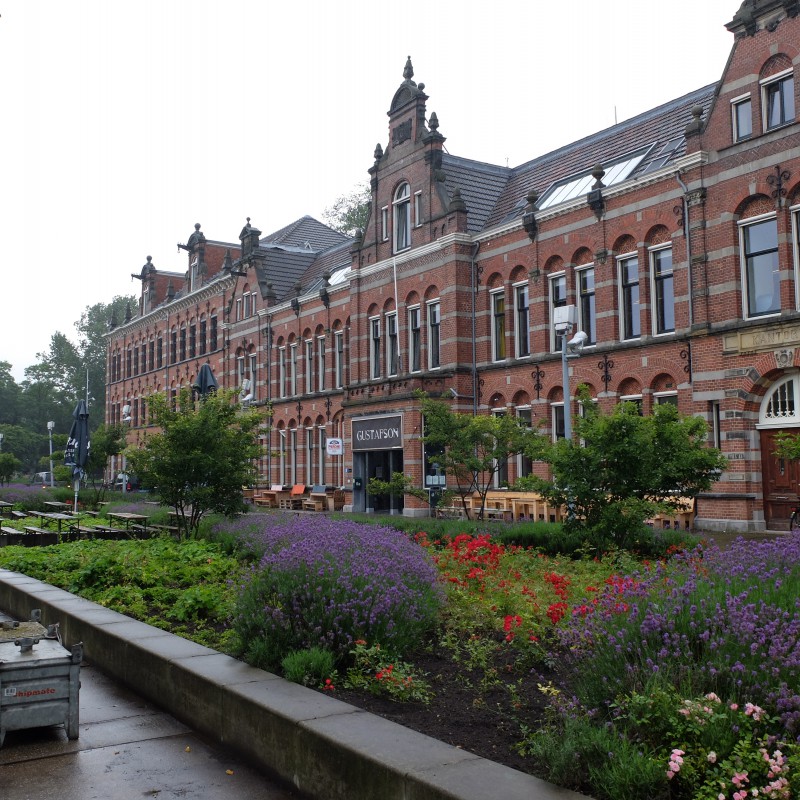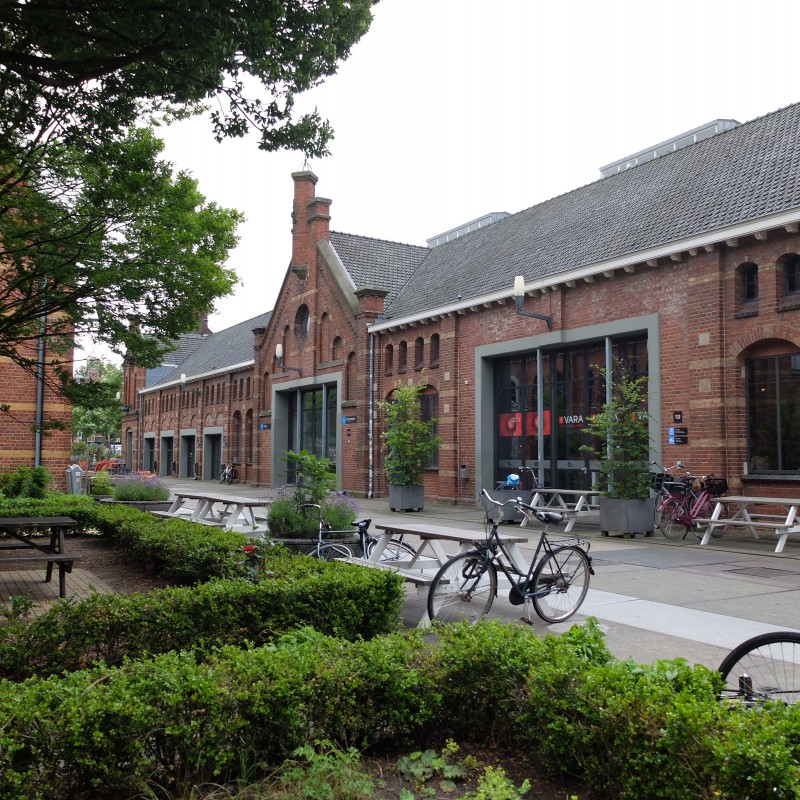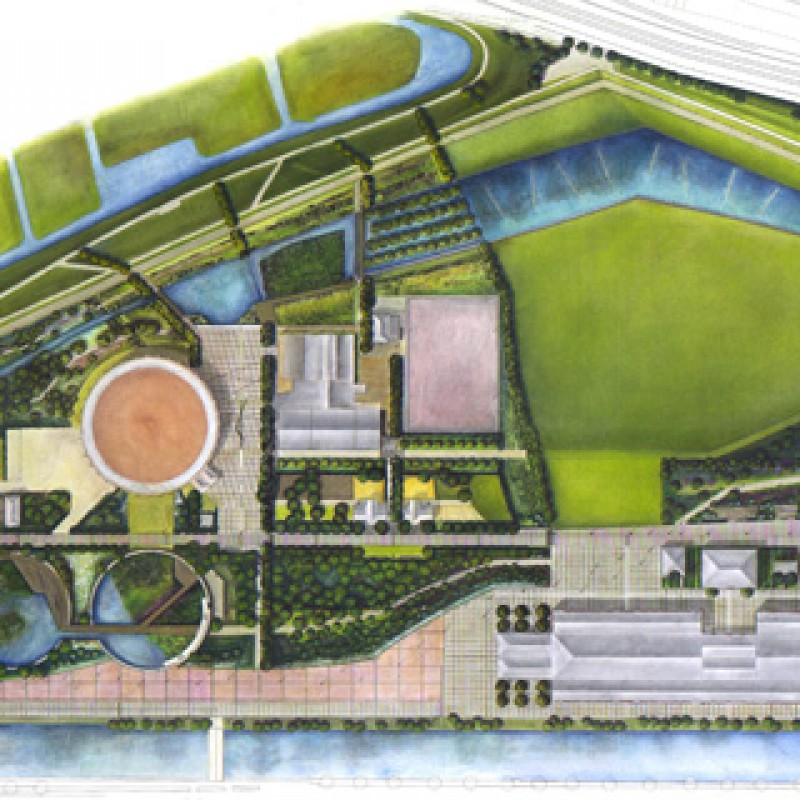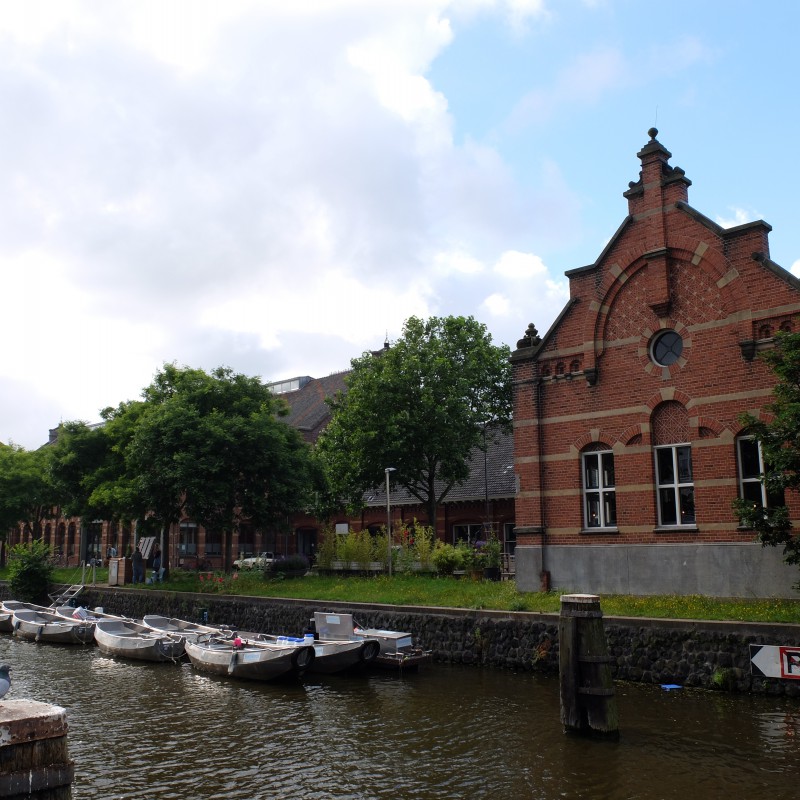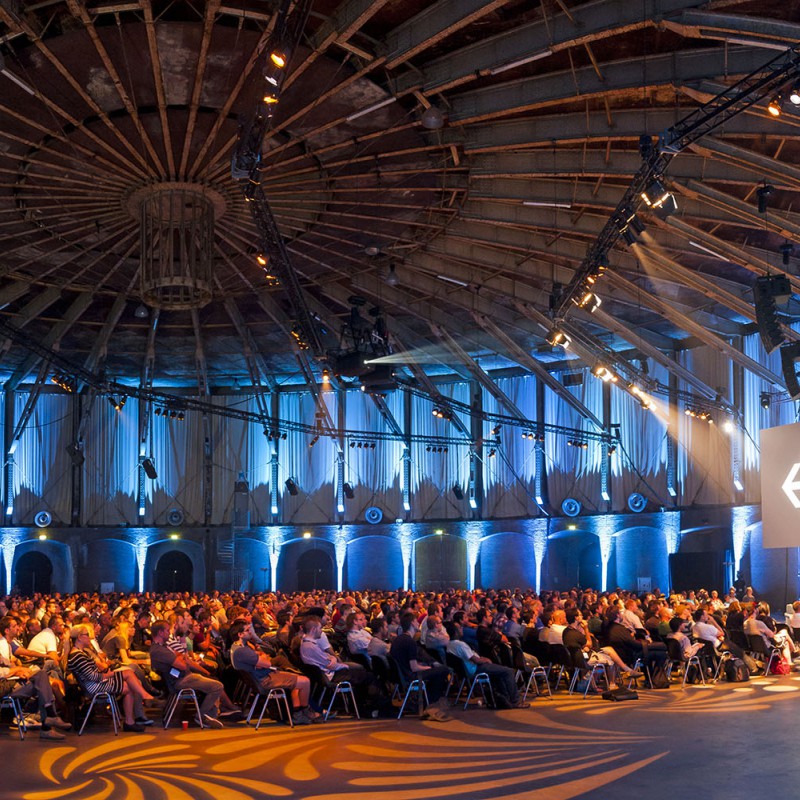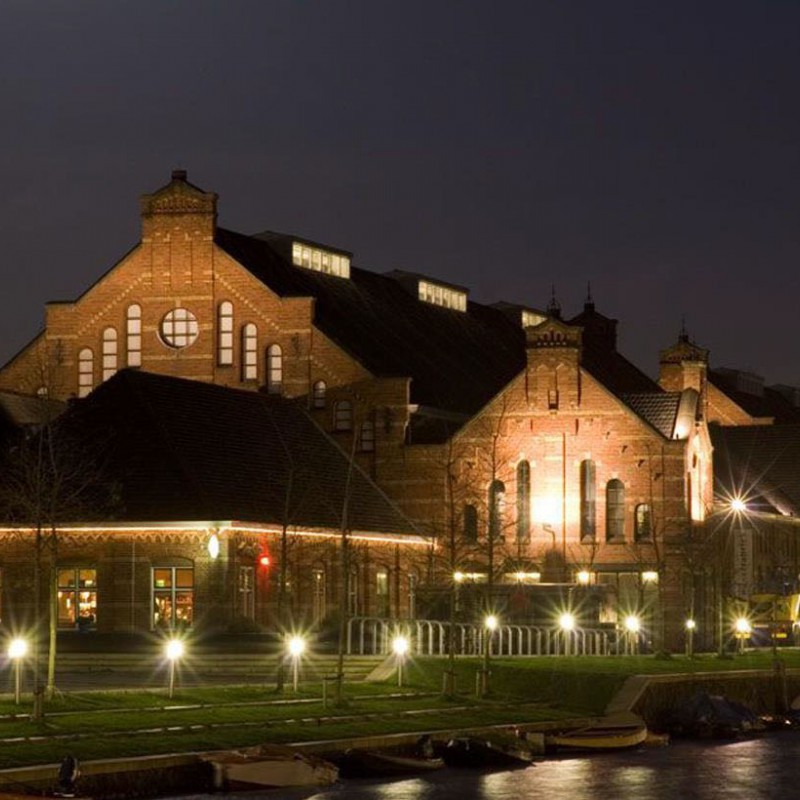Westergasfabriek
Pazzanistraat 33 1014 DB Amsterdam, Netherlands
| Former Use: | Gasworks |  |
| New Use: | Cultural and recreation park, hotel | |
| Category: | Commerce/retail, Culture, HoReCa, Office, Recreation | |
| Website: | http://www.westergasfabriek.nl/ | |
| Original Architect: | Isaac Gosschalk | |
| Reuse Architect: | Architectenbureau Braaksma & Roos | |
| Construction year(s): | 1885 - | |
| Reuse year(s): | 1993 - 2005 |
Description:
Historic use
The Westergasfabriek was one of the two coal gas factories of Amsterdam, founded by the Imperial Continental Gas Association (ICGA). Its construction was completed in 1885 and its product was originally used for street lighting. Designed by the Architect Isaac Gosschalk, the complex was built in the Hollandse Neorenaissance style with some eclectic features and innovative structural methods. (Somer and Lankamp, 1998)
In 1898 the Westergasfabriek was passed to the hands of the city of Amsterdam. The following years saw the increase of the production and the successive extension of the complex with new structures including the large gasholder (1902), the boilerhouse (1903) et al. From 1955-1962 the plant was expanded again, to become redundant only five years later.
In the course of the complex’ operation several buildings were demolished (e.g. ammonia building in 1933, purifier building and retort house in 1961) a process that was intensified after the closure of the gasworks. (water tower demolished in 1968, two gasholders and a water gas plant demolished in 1974. (Koekebakker, 2003,28-29).(Nieuwmeijer and Kuipers, 1983)
Reuse Preparation
The complex series of events that started building up since the late 1970s and led to the interim use of the plant in 1993 is described in detail in the book “Cultuurpark Westergasfabriek. Transformatie van een industrieterrein” (Koekebakker, 2003, 29-33) It is however important to clarify who took the initiative and why as well as naming both factors that accelerated the process and those that hindered it.
Surprisingly, the safeguarding of the Westrgasfabriek from the bulldozers was initially not the goal but the side-effect of the surrounding neighbourhood ‘s struggle for an urban park. Their resistance to destructive redevelopment schemes and their determination activated the City Council (C.C.), which assigned a recreational function to the Westergasfabriek by passing a land use ordinance in 1981.
Westergasfabriek remained underused for twelve more years. This delay stemmed from intrinsic factors of the complex, such as its high pollution levels as well as extrinsic factors. The later involved a hazy administrational climate, linked to the decentralisation of the City of Amsterdam into Districts, and a lengthy and eventful stakeholders’ consultation process. The posed process, led by the local authority, was truly horizontal, involving multiple design calls for ideas for the park and the buildings and much deliberation between stakeholders.
An important step towards the reuse of the plant, taken by the District Council (D.C) in 1990, was the establishment of the project-office Westergasfabriek, directed by Evert Verhagen. In 1992 the reuse process was accelerated by the hasty leaving of the Municipal Energy Company, that was using the premises as workshops and storage since the late 1960s. Mobilised by the fear of having the complex squatted, the local authority decided to move on immediately with an interim use.
It is worth mentioning that despite the intent for a horizontal venture, the final decisions for the reuse of the buildings were rather top-down. When the shortlisted intended main permanent tenant withdrew in 1995, the D.C. decided to stop the consultation approach and proceed with what had been proved successful in the interim use.
Interim Use
In 1992 Verhagen appointed Liesbeth Jansen as a project leader for events. Jansen, who had an extensive network in the artistic community of Amsterdam was asked to find temporary users in less than two weeks. Despite the frenetic pace of the tenants selection process, she managed to set criteria for achieving an interesting cultural atmosphere, preserving the character of the buildings and creating conditions for social interaction between users and visitors. (Cerutti, 2011, 90)
L. Jansen discussing the critical decisions that drove the interim use states:
“We figured that art & culture would show the potential of the buildings. I made sure that we would not need any subsidy by hosting commercial events who paid for the rent so to say. As a result, we came up with the solution of combining permanent lease and temporary events. Also, since the buildings were not listed yet there was the danger of demolition. A cultural spot attracts a lot of people, generates interest about the site and thus is a good way to prevent demolition.”
The public was allowed in the complex the 1st of June 1993 and responded with great enthusiasm. The interim use was planned to be only a one-year temporary phase yet it finally lasted seven years. During this period no action was taken for the preservation of the complex yet a lot was achieved.
E. Verhagen highlighting some of the merits of the interim use argues:
“The Temporary use taught us how to use the buildings and make the park a connector between functions. It also showed us that culture, in the form of cultural enterprise, was a financially sustainable use.”
The interim use had a threefold positive contribution to the project. First, it served as a test phase highlighting a financially and socially sound future use and operational challenges. Second, it generated interest and awareness among various stakeholders on a local and national level. The later was used as an indirect pressure point for the listing of the complex, materialized in 1999. (Nationale Agenda Herbestemming, 2015) Third, it prevented vacancy and in turn the structural deterioration of the complex
This phase though albeit rewarding was not problem free. Operational problems, such as the resolution of safety issues were rising. Moreover, after the first year a tension started to be building up among the tenants who were gradually demanding a more stable position in the complex.
Reuse process
The location, scale and status of the Westergasfabriek, the growing appeal of its interim use as well as the vigorous action of the local community for the Westerpark development made the project more and more important for the D.C. and the C.C. of Amsterdam as well as the Central Government. The engagement of the C.C. with the process in the mid-1990s was expressed with the appointment of Edgar Peer as project alderman. The later had a massive impact on the future direction of the process, as he instigated its privatisation and the development of 3.500 of new buildings in the eastern part of the terrain.
From 1996 to 2000 three very important decisions took place. Kathrin Gustafson was selected as the architect of the park, a development plan that was assigning a cultural function to the complex was passed by the D.C. and the complex was sold to the development company MAB with the obligation to restore and make it fit for its future cultural function. (Koekebakker, 2003, 51)
The transfer of the ownership from the public to the private sector was, according to this research’ respondents, quite hard. The developer was perceived both by the D.C. and the local community with suspicion and unease. The D.C. and MAB co-signed a carefully drafted contract that had a double function. First, it analysed the delegation of responsibilities between the two parties and second it set some standards in terms of the nature and character of the future function, the operation of the complex, profit margins et.al.
As soon as MAB took over, they set up Westergasfabriek B.V., a management and operating company for the complex. L. Jansen, who had played an important role in the interim use was offered the position of the managing director. Another key decision was the selection of the architectural office Braaksma and Roos for the redesign of the complex. Isaac Kalisvart, CEO of MAB at the time argues:
“We felt the need to change architects and not to move on with Mecanoo. Our goal was to maximise flexibility for future uses and preserve the authenticity. Stay truthful to the industrial architecture but find the best manner to accommodate future uses. For that we needed an architectural office to restore and not somebody who would be focused on adding something new.”
The construction of the park and the decontamination of the terrain started in 2000 while the restoration and reuse of the buildings begun two years later. This period was the most challenging phase of the project. The decontamination process proved to be far more complex, expensive and in turn lengthier than anticipated. The miscalculation of the needed funds for the decontamination resulted in a smaller budget for the restoration of the buildings.
“When we started we wanted to restore the buildings for at least 50 years but we had to review our ambition and go for a restoration of 20-30 years at the most. So we had to adjust the philosophy of the restoration because of the polluted situation.”, claims Olivier Graeven, project architect in Braaksma & Roos.
Furthermore, according to E. Vehagen the decontamination drove away some of the users, it created some unease in the neighbourhood and most importantly, it caused significant problems with the developer. The mutual obligations defined in the aforementioned contract and the courage of the D.C. to stand guarantee so that the developer could secure a loan from the National Restoration Fund, finally saved the project from collapsing. The decontamination process and the construction of the park were completed in 2003 while the restoration and transformation of the buildings was completed by 2007.
The philosophy of the architects was decisive as it determined the character and aesthetics of the complex. Job Roos, partner and co-founder of Braaksma en Roos architectenbureau explains:
“The vision for the restoration was to leave it as it is. You really do not want to polish on the dirt…You do not want to do too much. However, you have to understand the buildings very precisely because then you can decide what to do and what not to do. […]We wanted to have everything open for future use and at the same time to preserve the heritage values.[…] You bring architecture with the most societal relevance. It is not so much about the design itself, it is about the use. There were a lot of iconic things already so you do not have to be so iconic. You just have to go with what is there…”
Operation
Since the mid-2000 when the terrain was opened again to the public, the Westergasfabriek is functioning as a cultural hotspot of Amsterdam. In combination with the Westerpark, it is a pole of attraction with a massive appeal on a local and national level. The terrain is managed by a private-public collaboration. The buildings, owned by the Meijer-Bergmans couple, are manged by the Westergasfabriek BV while the Westerpark is owned and managed by the DC.
The mixed scheme of permanent tenants and temporary events, which had been proven successful during the interim use, has been retained. The permanent tenants include mainly cultural entrepreneurs such as creative companies, cultural and entertainment organisations. (Westergasfabriek BV, 2015) According to Nurah Abdulkadir, Marketing Communication manager, Westergasfabriek BV, the company organises in average 250 events per year, excluding those organised by the permanent tenants. These events, which vary from a meeting of 10 persons to a conference of 3000 people, attract more than 650.000 people yearly in the event buildings, excluding the visitors of the tenants and park visitors.
Currently, two new developments are taking place in the terrain on the initiative of Westergasfabriek BV. The first one is the sustainability upgrade of the complex, that includes improvements in the isolation of the buildings, enhancement of their energy consumption and an innovative waste management method. The second one is the transformation of the historic office building, that served formerly as the DC headquarters, to a hotel. Aiming to foster sustainability as one of the chore characteristics of the complex, Westergasfabriek BV has chosen Conscious Hotels, an eco-friendly hotel chain for this venture. (Abdulkadir, N. 2016, interview)
Another action that is currently under way, organised by the Friends of the Westerpark is the formulation of a small core of public facilities for the neighbourhood in the park. These will include a canteen, a tennis court, a table tennis and toilets. “It will be a non-for-profit social place” states Jack van Lieshout, member of the Friends of the Westerpark.
Shifts
In the course of the operation of the Westergasfabriek a lot has changed. The shifts can be traced more on an administrational, program and social level that on a spatial one. In the opinion of N. Abdulkadir, the shift is a natural process, related also with the owner’s agenda and the change in the company’s director, that took place in 2010. She explains "we have gotten more mature, more professional and you can see that also in the kind of tenants we attract and we can host, too.”
The posed professionalism has two opposite sites. On the one hand, it secures the project’s durability, offering the owner higher rents and more reliable business partners. On the other hand though, it significantly affects the new identity of Westergasfabriek. Since 2010, a continuous corrosion of the cultural character of the complex is taking place, giving way to commercial functions. This development seems to cause serious concerns among the striking majority of the project’s stakeholders as shown from their statements:
“There is a tendency for more money making. The place is becoming progressively less underground and more a business. It is becoming more and more commercial. Formerly, the events were organised by artists and now as you see they are organised by big corporations like Nike.” , explains a tenant of Westergasfabriek since 2006
“We had agreed that the function would be cultural and there will be a differentiation in the rent prices, offering both low rent spaces and commercial spaces. Nowadays, the complex has become too expensive for cultural users. There are still festivals but they are all commercial now. I still believe that it is successful because it is mixed but there is too much HORECA." Martine Fransman, formerly D.C. Alderwoman.
“The district made some rules that were never applied. For example, they set a maximum amount of retail and restaurants. They did that in order to keep start-ups in house. Nowadays, most of the start-ups have been kicked out because they cannot afford the high rent. They prefer leisure and HORECA as they generate more profit. So I am afraid that the project is being commercialised.” E. Verhagen
In parallel with the mutation of the Westergasfabriek character a continuous process of gentrification is taking place in the surrounding neighbourhood.
“A PhD study showed that after the reuse of the complex the values of the area have risen more than any other area in Amsterdam in the past 10 years. So on a more statistical level you see the upgrade of the residential area. Also the neighbourhood has become more popular, which is a good outcome. On the other hand, along with the neighbourhood the type of people who come to live here changes. I do not know if that is a good or a bad thing.”, states N. Abdulkadir.
Relevant Literature:
- Baum. M, Christiaanse. K., 2012, City as Loft. Adaptive Reuse as a Resource for Sustainable Urban Development, Zurich: Verlag, pp.126-129
- Marge Cerutti, V. 2011. Creatieve fabrieken: waardecreatie met herbestemming van industrieel erfgoed, C2Publishing.
- Koekebakker, O. 2003. Cultuurpark Westergasfabriek: transformatie van een industrieterrein, NAi Uitgevers.
- Nationale Agenda Herbestemming. 2015. Westergasfabriek, Amsterdam Available: [Accessed 15 November 2016].
- Nieuwmeijer, G. G. & Kuipers, M. 1983. De westergasfabriek te amsterdam. Industriele archeologie, 155-168.
- Somer, K. & Lankamp, P. 1998. Westergasfabriek: het terrein en de gebouwen: een cultuurhistorische verkenning, Bureau Monumentenzorg.
- Stadsdeel Wpark Project Westergasfabriek Available: [Accessed 15 November 2016].
- Westergafabriek BV. 2015. Permanent tenants. Available: [Accessed 17 November 2016].
